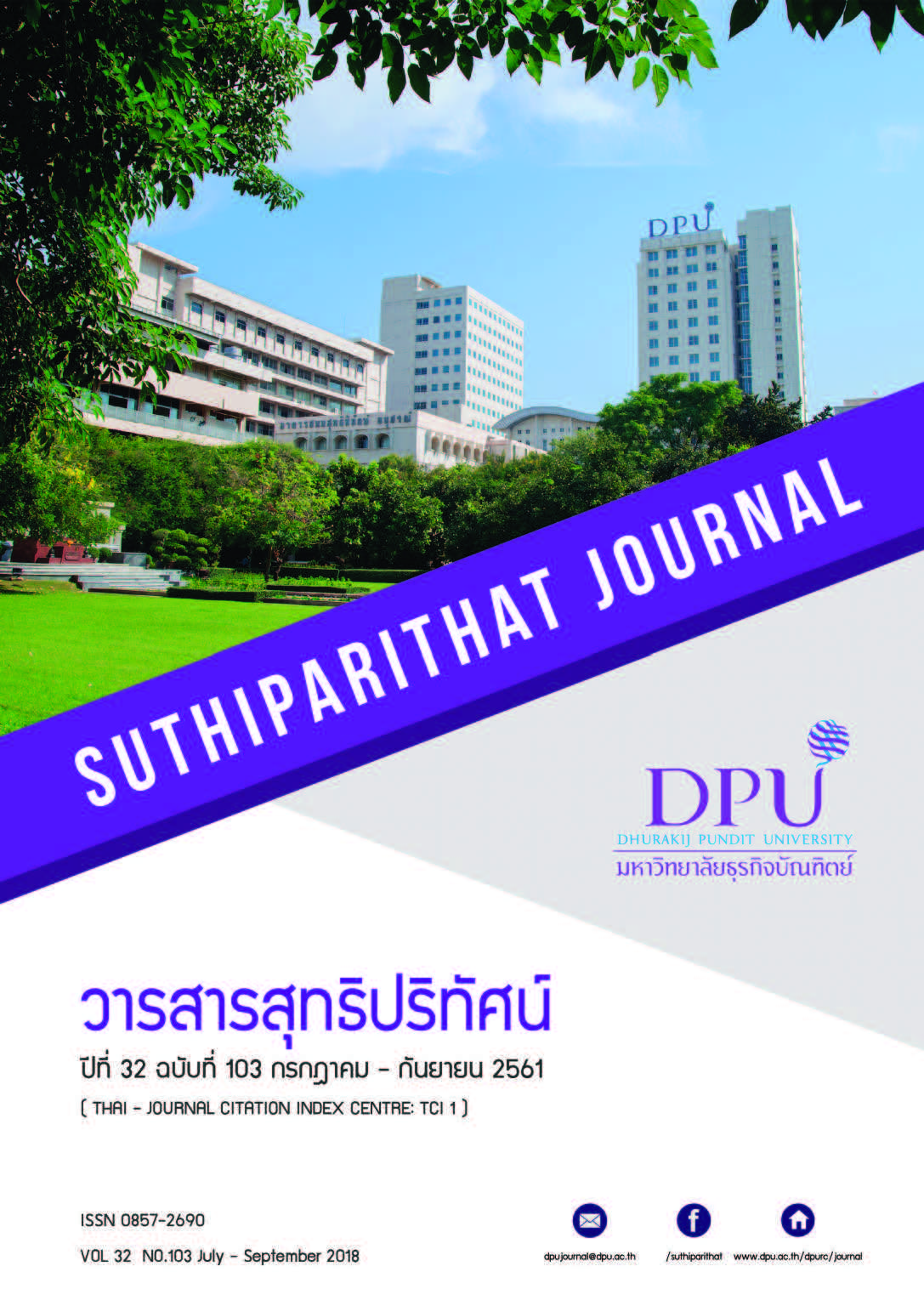การสอบบัญชีในยุค Big Data
คำสำคัญ:
แหล่งข้อมูลขนาดใหญ่, การสอบบัญชีบทคัดย่อ
การสอบบัญชีภายใต้สภาพแวดล้อมที่ Big Data เข้ามามีบทบาทสำคัญกำลังเป็นความท้าทายที่ผู้สอบบัญชีต้องเผชิญ ซึ่งปัจจัยสำคัญสู่ความสำเร็จของการสอบบัญชีในยุคนี้คือการพิจารณาหาแนวทางการใช้ประโยชน์จากข้อมูล Big Data อย่างเป็นระบบ ดังนั้นเพื่อเป็นการเตรียมความพร้อมให้กับผู้ประกอบวิชาชีพ สอบบัญชีตลอดจนทุกฝ่ายที่เกี่ยวข้องในการรองรับการเปลี่ยนแปลงของการสอบบัญชีในอนาคต บทความ วิชาการฉบับนี้จึงจัดทำขึ้นเพื่อนำเสนอความรู้ความเข้าใจพื้นฐานเกี่ยวกับ Big Data ความหมายของ Big Data ในบริบทของงานสอบบัญชี การประยุกต์ใช้ศาสตร์การวิเคราะห์ข้อมูล (Data Analytics) กับการสอบ บัญชี และข้อเสนอแนะสำหรับแนวทางในการบูรณาการ Big Data กับการสอบบัญชีอย่างมีประสิทธิภาพ โดยทั่วไปการบูรณาการควรประกอบด้วยผู้ที่เกี่ยวข้องทั้งหมด 3 ฝ่าย คือ องค์กรผู้รับบริการสอบบัญชี สำนักงานสอบบัญชี และหน่วยงานสนับสนุนภายนอก ได้แก่ สถาบันการศึกษาและสภาวิชาชีพบัญชี และ เพื่อให้การบูรณาการเกิดการขับเคลื่อนอย่างเป็นรูปธรรมและมีประสิทธิภาพ ควรพิจารณาในประเด็นที่สำคัญ 2 ส่วน คือ การวิเคราะห์ระดับการใช้ Big Data ขององค์กรผู้รับบริการสอบบัญชีในการดำเนินธุรกิจที่จะมีผลต่อการสอบบัญชีเพื่อให้สำนักงานสอบบัญชีสามารถปรับตัวให้กับสภาพแวดล้อมของการตรวจสอบที่เปลี่ยนแปลงไป และการพิจารณาบทบาทและหน้าที่ของหน่วยงานสนับสนุนที่ควรมี
เอกสารอ้างอิง
ธนชาติ นุ่มนนท์. (2558). เทคโนโลยีสำหรับ Big Data: Storage และ Analytics. สืบค้น 23 สิงหาคม 2560, จาก https://thanachart.org/2015/08/17.
ธนาวัฒน์ มาลาบุปผา. (2560). Big Data ข้อมูลสร้างคุณค่าอาวุธพิชิตใจลูกค้ายุคดิจิทัล. สืบค้น 5 พฤษภาคม 2561, จาก https://www.growthbee.com/big-data-digital-customers/.
ธีรเกียรติ์ เกิดเจริญ. (2555). Big Data ยุคข้อมูลใหญ่มหึมามาถึงแล้ว. สืบค้น 12 สิงหาคม 2560, จาก http://nano-in-thailand.blogspot.com/2012/06/big-data.html
เยาวลักษณ์ ชาติบัญชาชัย และโสภณ เพิ่มศิริวัลลภ. (2559). คำถามที่พบบ่อย (FAQ) เกี่ยวกับ Big data และ Data analytics. Boardroom, 48, 30-35.
โสภณ เพิ่มศิริวัลลภ. (2559). กระแสแห่งนวัตกรรมทางเทคโนโลยีกับวิชาชีพสอบบัญชี. วารสารวิชาชีพบัญชี, 12(34), 59-62.
Alles, M., & Gray, G. L. (2015). The Pros and Cons of Using Big Data in Auditing: A Synthesis of the Literature. Retrieved August 18, 2017, from http://jebcl.com/symposium/wpcontent/uploads/2015/09/The-Pros-and-Cons-of-Using-Big-Data-in-Auditing-A-Synthesis-of-the-Literature-UWCISA-Revised.pdf.
American Institute of Certified Public Accountant. (2015). Audit Analytics and Continuous Audit Looking Toward the Future. Retrieved December 9, 2017, from https://www.aicpa.org/interestareas/frc/assuranceadvisoryservices/downloadabledocuments/auditanalytics_lookingtowardfuture.pdf
Appelbaum, D., Kogan, A., & Vasarhelyi, M. (2015). Moving towards continuous audit and big data with audit analytics: Implications for research and practice, 35th World Continuous Auditing & Reporting Symposium. Organized by Rutgers Accounting Research Center (RARC) and Continuous Auditing & Reporting Laboratory (CAR-Lab).
Association to Advance Collegiate Schools of Business. (2014). AACSB International Accounting Accreditation Standard A7: Information Technology Skills and Knowledge for Accounting Graduates: An Interpretation. Retrieved January 18, 2018, from http://www.aacsb.edu/-/media/aacsb/publications/white-papers/accounting-accreditation-standard-7.ashx?la=en.
Centre of Financial Reporting Reform – World Bank Group. (2017). Audit Data Analytics: Opportunities and Tips. Retrieved August 26, 2017 from http://siteresources.worldbank.org/EXTCENFINREPREF/Resources/4152117-1427109489814/SMPs_spreads_digital.pdf
Certified Public Accountant Canada. (2016). Audit Data Analytic Alert: Keeping Up With the Pace of Change. Retrieved December 9 2017, from https://www.cpacanada.ca/-/.../01186-rg-auditdata-analytics-alert-keeping-up-with-pa.
Dumbill, E. (2012, January 11). What is Big Data? An introduction to the Big data landscape.Retrieved August 12, 2017, from http://radar.oreilly.com/2012/01/What-is-big-data.html
Early, C. E. (2015). Data analytics in auditing: Opportunities and challenges. Accounting Horizontal, 58, 493-500.
Fisher, L. (2015). Big data transforming how audits are carried out. AB Magazine. Retrieved January 20, 2018, from http://www.accaglobal.com/pk/en/member/member/accounting-business/insights/big-data.html.202
Gartner. (2012). Gartner Says Big Data Will Drive $28 Billion of IT Spending in 2012. Press Release, October 17th. Retrieved December 9, 2017, from http://www.gartner.com/newsroom/id/2200815.
International Auditing and Assurance Standards Board’s Data Analytics Working Group. (2016). Exploring the Growing Use of Technology in the Audit, with a Focus on Data Analytics. Retrieved August 15, 2017, from https://www.ifac.org/publications-resources/exploringgrowing-use-technology-audit-focus-data-analytics
Krahel, J. P., & Titera, W. R. (2015). Consequence of Big Data and Formalization on Accounting and Auditing Standard. Accounting Horizontal, 29(2), 409-422.
Liu, Q. (2014). The application of exploratory data analysis in auditing (Doctoral dissertation, RutgersUniversity-Graduate School-Newark).
Stewart, T. R. (2015). Data Analytics for Financial Statement Audits. Audit Analytics and Continuous Audit: Looking Toward the Future (pp.105-128). New York: Author
Tang, J. J., & Karim, K. E. (2017). BIG DATA in Business Analytics: Implications for the Audit Profession. CPA Journal, 87(6). Retrieved August 15, 2017, from http://www.cpajournal.com/2017/06/26/big-data-business-analytics-implications-audit-profession/
Wang, R. (2011, February 27). Monday’s musing: Beyond The three V’s of big data-Viscosity and virality. Retrieved August 12, 2017, from http://www.forbes.com/sites/raywang/2012/02/27/Mondays-musings-beyond-the-three-vs-of-big-data-viscosity-and-virality/
ดาวน์โหลด
เผยแพร่แล้ว
รูปแบบการอ้างอิง
ฉบับ
ประเภทบทความ
สัญญาอนุญาต
เนื้อหาและข้อมูลในบทความที่ลงตีพิมพ์ในวารสารสุทธิปริทัศน์ ถือเป็นข้อคิดเห็นและความรับผิดชอบของผู้เขียนบทความโดยตรงซึ่งกองบรรณาธิการวารสาร ไม่จำเป็นต้องเห็นด้วย หรือร่วมรับผิดชอบใด ๆ
บทความ ข้อมูล เนื้อหา รูปภาพ ฯลฯ ที่ได้รับการตีพิมพ์ในวารสารสุทธิปริทัศน์ ถือเป็นลิขสิทธิ์ของวารสารสุทธิปริทัศน์หากบุคคลหรือหน่วยงานใดต้องการนำทั้งหมดหรือส่วนหนึ่งส่วนใดไปเผยแพร่ต่อหรือเพื่อกระทำการใด ๆ จะต้องได้รับอนุญาตเป็นลายลักษณ์อักษรจากวารสารสุทธิปริทัศน์ก่อนเท่านั้น







